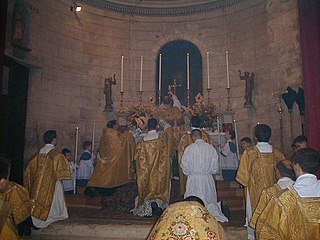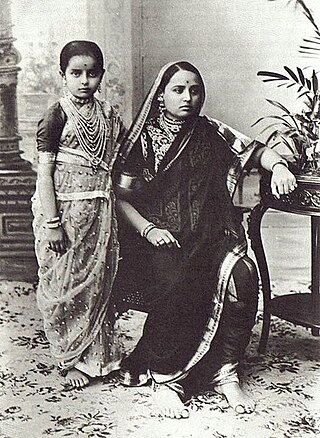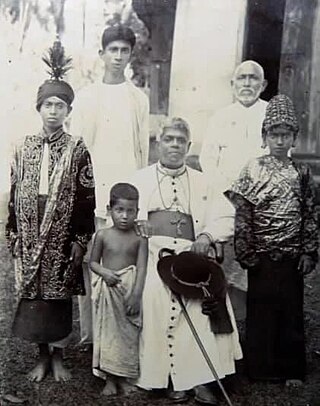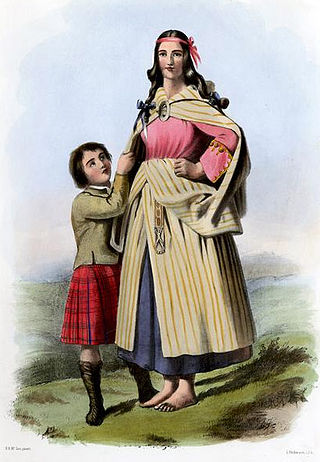
A sweater or pullover, also called a jersey or jumper, is a piece of clothing, typically with long sleeves, made of knitted or crocheted material, that covers the upper part of the body. When sleeveless, the garment is often called a slipover, tank top or sweater vest.

A shirt is a cloth garment for the upper body.

Vestments are liturgical garments and articles associated primarily with the Christian religion, especially by Eastern Churches, Catholics, Anglicans, and Lutherans. Many other groups also make use of liturgical garments; this was a point of controversy in the Protestant Reformation and sometimes since, in particular during the ritualist controversies in England in the 19th century.

A sari is a women's garment from the Indian subcontinent, that consists of an un-stitched stretch of woven fabric arranged over the body as a robe, with one end tied to the waist, while the other end rests over one shoulder as a stole (shawl), sometimes baring a part of the midriff. It may vary from 4.1 to 8.2 metres in length, and 60 to 120 centimetres in breadth, and is form of ethnic wear in India, Pakistan, Bangladesh, Sri Lanka and Nepal. There are various names and styles of sari manufacture and draping, the most common being the Nivi style. The sari is worn with a fitted bodice commonly called a choli and a petticoat called ghagra, parkar, or ul-pavadai. It remains fashionable in the Indian Subcontinent today.

A sarong or a sarung is a large tube or length of fabric, often wrapped around the waist, worn in Southeast Asia, South Asia, Western Asia, Northern Africa, East Africa, West Africa, and on many Pacific islands. The fabric often has woven plaid or checkered patterns, or may be brightly colored by means of batik or ikat dyeing. Many modern sarongs have printed designs, often depicting animals or plants. Different types of sarongs are worn in different places in the world, notably the lungi in the Indian subcontinent and the izaar in the Arabian Peninsula.
Clothing in India is dependent upon the different ethnicities, geography, climate, and cultural traditions of the people of each region of India. Historically, male and female clothing has evolved from simple garments like kaupina, langota, achkan, lungi, sari, well as rituals and dance performances. In urban areas, western clothing is common and uniformly worn by people of all social levels. India also has a great diversity in terms of weaves, fibers, colours, and material of clothing. Sometimes, color codes are followed in clothing based on the religion and ritual concerned. The clothing in India also encompasses the wide variety of Indian embroidery, prints, handwork, embellishment, styles of wearing clothes. A wide mix of Indian traditional clothing and western styles can be seen in India.

The lungi is a type of sarong that originated in the South Asia. The lungi, which usually multicoloured, is a men's skirt usually tied around the lower waist below the navel. it can be worn as casual wear and night wear, in places and climates where the heat and humidity increase sweating, and make it unpleasant or uncomfortable to wear closed and tight clothes such as trousers.

The mundu is a garment worn around the waist in the Indian states of Kerala, Tamil Nadu, the Lakshadweep archipelago, and the Indian Ocean island nation of Maldives. It is closely related to sarongs like dhotis and lungis. It is normally woven in cotton and coloured white or cream. The colour is dependent on whether the cotton is bleached or unbleached. A khadaṟ muṇṭŭ is made using handlooms. When unbleached, the mundu is called nēriyatu. In modern times, two types of mundu are prevalent—the single and the double. A single mundu is wrapped only once around the waist, while the double one is folded in half before wearing. A mundu is usually starched before use.

The Knānāya, also known as the Southists or Tekkumbhagar, are an endogamous ethnic group found among the Saint Thomas Christian community of Kerala, India. They are differentiated from another part of the community, known in this context as the Northists (Vaddakkumbhagar). There are about 300,000 Knanaya in India and elsewhere.

The quechquemitl is a garment which has been worn by certain indigenous ethnicities in Mexico since the pre-Hispanic period. It usually consists of two pieces of rectangular cloth, often woven by hand, which is sewn together to form a poncho or shawl like garment, which is usually worn hanging off the shoulders. It can be constructed of various different fabrics, often with intricate weaves, and is typically highly decorated, most often with embroidery.

A religious habit is a distinctive set of religious clothing worn by members of a religious order. Traditionally some plain garb recognizable as a religious habit has also been worn by those leading the religious eremitic and anchoritic life, although in their case without conformity to a particular uniform style.

Huipil[ˈwipil] is the most common traditional garment worn by indigenous women from central Mexico to Central America.

Margamkali is an ancient Indian round dance of the St. Thomas Christians community- based in Kerala state, mainly practiced by the endogamous sub-sect known as the Knanaya or Southist Christians. The dance retells the life and missionary work of Thomas the Apostle, based on the 3rd-century apocryphal Acts of Thomas.

Mundum neriyatum is the traditional clothing of women in Kerala, a state in southwestern India. It is the oldest remnant of the ancient form of the sari which covered only the lower part of the body. In the mundum neriyatum, the most basic traditional piece is the mundu or lower garment which is the ancient form of the sari denoted in Malayalam as tuṇi, while the nēriyatu forms the upper garment the mundu. The mundum neriyatum consists of two pieces of cloth, and could be worn in either the traditional style with the nēriyatu tucked inside the blouse, or in the modern style with the nēriyatu worn over the left shoulder.

Kerala sari (Set-sari) is a clothing of women in the Indian state of Kerala.

Sbai or phaa biang is a shawl-like garment or breast cloth worn in mainland Southeast Asia. Sbai is worn by women as a silk breast wrapper in Thailand, Laos, and Cambodia, while in coastal Sumatra, Borneo and Malay peninsula, the same term is used to describe a shoulder cloth. The sbai was derived from the Indian sari, the end of which is worn over one shoulder.

An earasaid, or arasaid is a draped garment worn in Scotland as part of traditional female highland dress. It may be a belted plaid, or an unbelted wrap. Traditionally, earasaids might be plain, striped or tartan; they might be brightly coloured or made of lachdan wool. Some colours were more expensive than others. Modern highland dress makes earasaids from the same heraldic tartan cloth used for kilts.

Traditional Thai clothing is called chut thai, which literally means 'Thai outfit'. It can be worn by men, women, and children. Chut thai for women usually consists of a pha nung or a pha chung hang, a blouse, and a pha biang. Northern and northeastern women may wear a pha sin instead of a pha nung and a pha chung hang with either a blouse or a suea pat. Chut thai for men includes a pha chung hang or pants, a Raj pattern shirt, with optional knee-length white socks and a pha biang. Chut Thai for northern Thai men is composed of a kangkeng sado, a white Manchu-styled jacket, and sometimes a khian hua. In formal occasions, people may choose to wear a so-called formal Thai national costume.
Kasavu is a technique used in handlooms of Kerala, with very fine threads of gold or silver used in weave to make border lines and designs on silk and cotton fabrics. This technique later spread to most of India and the Kasav technique was developed for many other fabrics across India. White or off-white cotton cloth with Kasav borders that originated in the South Indian state of Kerala is now famous as Kerala saree is believed to be first form of use of Kasav technique.
Angia is an obsolete form of bodice or breast-cloth of Indian origin dating from the 19th century, covering the entire upper body from bust to waist and tied at the back. Very short sleeves, if any, and high waist characterized the angia, which was made of fine cotton material such as muslin. Women in India wore it beneath dresses such as Peshwaj.



















